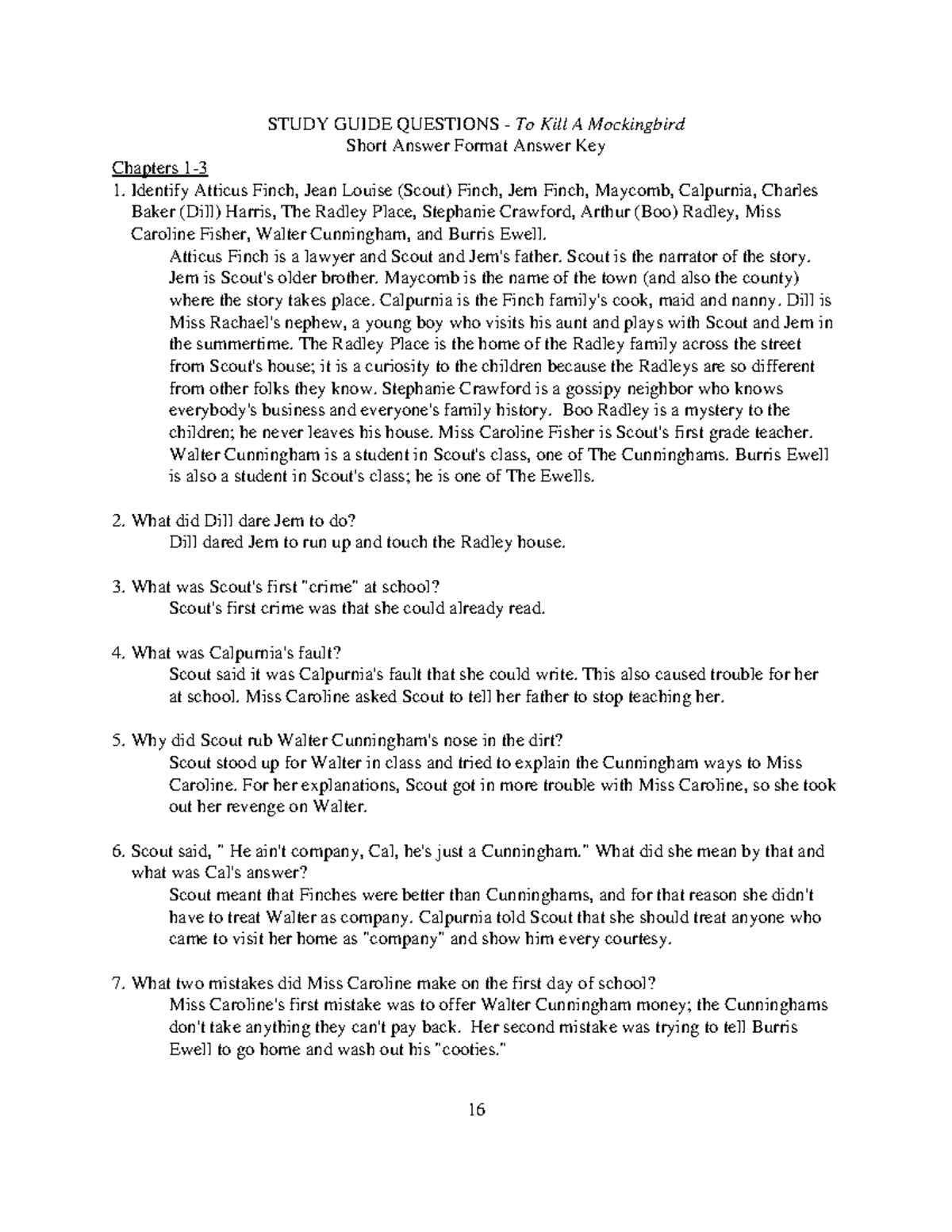
Harper Lee’s renowned novel delves into profound themes of morality, justice, and human compassion. Throughout the story, the characters face difficult choices and societal challenges, making it a powerful exploration of the human condition. This section aims to address crucial topics that arise from the narrative, offering insights into the characters’ motivations and the broader implications of their actions.
By examining pivotal moments in the book, we can better understand the complexities of race, class, and ethics that are woven into its fabric. The novel’s ability to provoke thought and discussion on these issues continues to resonate with readers worldwide. In this article, we will provide clarity on some of the most pressing subjects from the story, enriching your comprehension and interpretation of its timeless message.
Important Themes in To Kill a Mockingbird
Harper Lee’s novel addresses several key themes that explore the complexities of society, morality, and human nature. These central ideas are crucial for understanding the story’s message and the conflicts the characters face. Below are some of the most significant themes in the narrative.
- Racial Injustice – The novel explores how prejudice and racial discrimination shape individuals’ lives and their perceptions of justice, as exemplified in the trial of Tom Robinson.
- Empathy and Understanding – A recurring theme is the importance of seeing the world from others’ perspectives. Characters like Atticus Finch teach the value of empathy in confronting difficult situations.
- Morality and Ethics – Throughout the book, characters grapple with questions of right and wrong, particularly in relation to social expectations and personal beliefs.
- The Loss of Innocence – Scout and Jem’s experiences reflect the transition from childhood innocence to a more complex understanding of the world around them.
- Social Class and Inequality – The story highlights the divisions between different social groups in the town of Maycomb, illustrating how class and status influence individuals’ opportunities and perceptions.
These themes not only drive the plot forward but also encourage the reader to reflect on the moral implications of the characters’ actions. Each of these ideas plays a vital role in the overall message of the story, emphasizing the importance of integrity, fairness, and compassion in overcoming societal challenges.
Understanding Atticus Finch’s Moral Values
Atticus Finch stands as a moral beacon throughout the novel, guiding those around him with principles of fairness, justice, and integrity. His actions and decisions highlight the importance of doing what is right, even when faced with adversity. This section examines the core values that define Atticus and how they influence the characters around him.
The Importance of Justice
Atticus consistently advocates for justice, even when the system itself is flawed. His role as a lawyer allows him to challenge the prejudices of Maycomb, and his defense of Tom Robinson exemplifies his commitment to fairness regardless of social pressures.
- Equality Before the Law: Atticus believes in treating all people with equal respect and ensures that his legal approach reflects this ideal.
- Standing Against Injustice: He faces significant personal and professional risks in order to stand up for what is right, even when it contradicts the town’s prevailing beliefs.
Teaching Empathy
Atticus encourages his children, Scout and Jem, to practice empathy and understand others’ perspectives, a value central to his own moral compass. His famous advice to “climb into another person’s skin and walk around in it” emphasizes the importance of looking beyond one’s own experiences.
- Learning from Others: By showing understanding and respect for people from all walks of life, Atticus models how to navigate moral dilemmas.
- Imparting Compassion: He teaches his children that compassion is essential for resolving conflicts and fostering harmony in a divided society.
Atticus Finch’s unwavering commitment to his principles highlights the strength of moral values in challenging times. His ability to balance his professional responsibilities with personal integrity serves as a model for standing up against societal wrongs while maintaining respect for others. His teachings resonate long after the story ends, leaving a lasting impact on all who encounter his character.
The Role of Scout in the Story
Scout Finch, the young narrator of the novel, plays a pivotal role in shaping the reader’s understanding of the story. Through her eyes, the complexities of her small-town world are revealed, offering a unique perspective on the events unfolding around her. As a child, her innocence contrasts with the harsh realities of society, making her observations both insightful and poignant.
Her character serves as a lens through which the themes of morality, injustice, and personal growth are explored. As she matures, Scout learns to navigate the moral dilemmas and challenges that come with living in a divided community. Her interactions with the adults in her life, particularly her father, Atticus, help her develop a sense of right and wrong that transcends the biases of her peers.
Throughout the narrative, Scout’s development from a curious, sometimes rebellious child into a more thoughtful and empathetic individual is central to the story’s exploration of the loss of innocence. Her journey reflects the broader themes of personal growth, as she learns to understand the complexities of human behavior and the importance of standing up for what is right.
Key Events That Shape the Plot
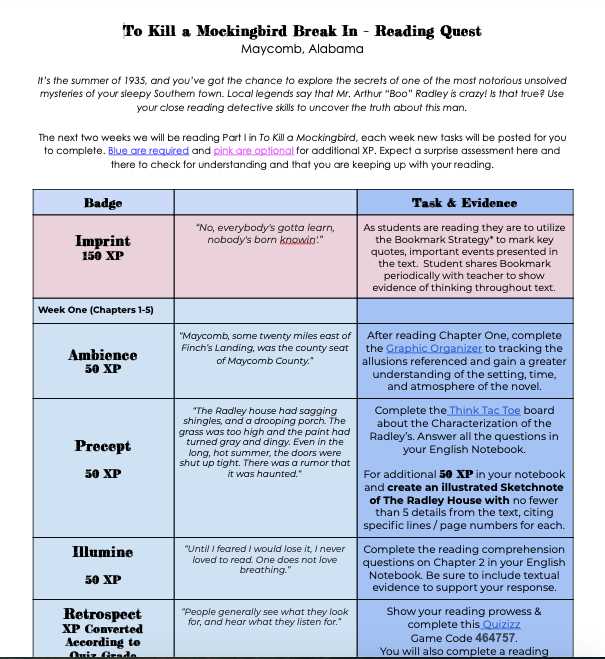
Throughout the novel, several pivotal moments drive the narrative forward, shaping the characters’ lives and the trajectory of the story. These significant events highlight the central conflicts, moral dilemmas, and moments of personal growth that define the themes of the book. Each turning point serves as a foundation for the broader social and ethical issues addressed in the narrative.
From the beginning, the trial of Tom Robinson stands as a key event that influences the characters’ development and the community’s response to racial prejudice. As the trial unfolds, it challenges the values of the town of Maycomb, forcing the characters to confront uncomfortable truths about justice and morality.
Another critical event occurs when Scout and Jem encounter Boo Radley, a figure of mystery and fear, yet whose actions ultimately demonstrate the themes of compassion and understanding. This encounter shifts the children’s perception of their world and further underscores the importance of empathy and looking beyond outward appearances.
These events, among others, serve to challenge the characters’ beliefs and perceptions, contributing to their personal growth and the eventual realization of the story’s deeper lessons. As the plot progresses, the characters are forced to reconcile their innocence with the harsh realities of the adult world, making these key moments crucial to the overall narrative arc.
Symbolism of the Mockingbird
In the novel, the idea of innocence and vulnerability is represented by a particular bird, which becomes a powerful symbol throughout the story. This symbol reflects the idea of purity being harmed by societal cruelty, making it a key theme in the narrative. The bird’s role in the plot is significant because it highlights the unjust treatment of individuals who do no harm, yet become victims of prejudice.
Innocence and Harm
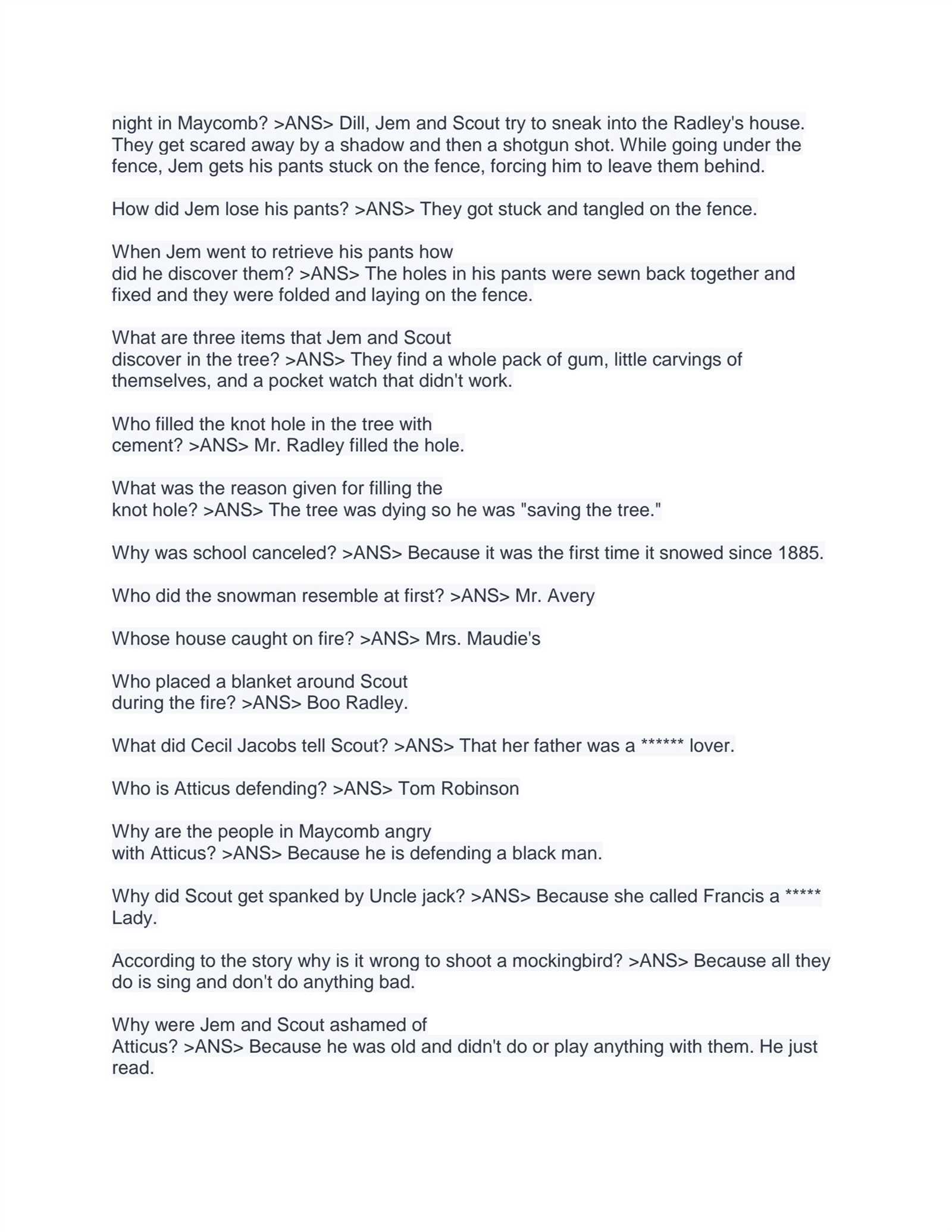
The bird symbolizes the harm caused by prejudice and injustice, particularly when innocent individuals are targeted due to societal biases. It is a metaphor for those who are wrongfully accused or oppressed.
- Tom Robinson: A symbol of goodness who is unjustly condemned, much like the bird that does no harm yet is destroyed.
- Boo Radley: Another character whose innocence is misunderstood and who is unfairly judged by society, yet ultimately proves to be kind-hearted.
The Importance of Protecting the Innocent
In the context of the story, harming something innocent is portrayed as an act of cruelty. The metaphor of the bird serves as a reminder of the importance of safeguarding those who are vulnerable in society.
- Atticus Finch: He teaches his children the value of protecting those who cannot defend themselves, emphasizing that it is wrong to harm what is pure and harmless.
- The Town of Maycomb: The collective attitudes and actions of the townspeople reflect a failure to protect those who need it most, especially those who are marginalized.
This symbolism resonates throughout the novel, reinforcing the central themes of injustice, compassion, and the loss of innocence. It serves as a constant reminder of the destructive power of prejudice and the need to protect what is pure in society.
The Significance of Maycomb, Alabama
The small town of Maycomb serves as a central setting for the novel, its social dynamics and cultural attitudes shaping much of the story’s conflict. The town is not just a backdrop, but a character in itself, representing the broader societal issues of the time. Its traditions, divisions, and attitudes provide a reflection of the struggles the characters face, particularly in relation to race, justice, and morality.
Social Structure and Divisions
Maycomb is a microcosm of the larger societal issues, where social status, race, and family history define an individual’s place in the community. The rigid class system influences every aspect of life in the town, from relationships to legal matters. The people of Maycomb are often divided along lines of race, class, and heritage, which creates a deeply entrenched system of prejudice and discrimination.
- Class Distinctions: The town is divided into clear social strata, with families like the Finches seen as respectable, while others, such as the Ewells, are stigmatized.
- Racial Tensions: The residents of Maycomb grapple with racial inequalities, which are most prominently displayed in the trial of Tom Robinson and the town’s reaction to it.
The Town as a Reflection of Moral Values
Maycomb’s values and attitudes significantly influence the characters’ decisions, particularly in the face of injustice. The way the townspeople react to events such as Tom Robinson’s trial illustrates the conflict between personal morality and societal norms. The town’s moral compass, or lack thereof, provides a crucial context for understanding the actions of key characters, especially Atticus Finch, who stands in opposition to the majority.
- Community Response: The town’s initial support of an unjust system contrasts sharply with the courage shown by a few individuals who challenge the status quo.
- Generational Influence: The attitudes of Maycomb are deeply ingrained in its citizens, with younger generations often influenced by their parents’ beliefs, both good and bad.
Maycomb’s role is more than just a setting; it is a reflection of the complex social issues that pervade the story, contributing to the novel’s exploration of morality, justice, and human behavior. The town’s flaws, while making it a place of tension, also provide a fertile ground for the characters to challenge societal norms and confront the injustices within their world.
Character Development of Jem Finch

Jem Finch undergoes significant personal growth throughout the novel, transitioning from a child full of idealism to a young adult faced with the harsh realities of his community. His journey mirrors the broader themes of innocence, morality, and justice, as he learns to grapple with complex issues that challenge his previously held beliefs. His experiences with his family, friends, and the people of Maycomb contribute to his evolving understanding of right and wrong.
At the start of the story, Jem is curious, playful, and somewhat naïve, viewing the world through the lens of childhood innocence. However, as the plot progresses, he is exposed to the prejudice and injustice that underpins his society. Key events, such as the trial of Tom Robinson and his own encounters with personal loss and disillusionment, mark the moments when Jem’s perspective shifts significantly.
His relationship with his father, Atticus Finch, plays a crucial role in shaping his moral compass. Atticus, who embodies fairness and integrity, provides Jem with the guidance needed to navigate the complexities of adulthood. Although Jem initially struggles with the town’s racial prejudices and the unfairness he witnesses, he gradually adopts his father’s values, embracing a deeper understanding of justice and empathy.
As the novel reaches its conclusion, Jem’s transformation is evident. He moves beyond the innocence of his early years and becomes more aware of the nuances of human nature. While he is still learning, Jem’s growth symbolizes the challenges faced by individuals when confronting difficult truths about the world they live in. His character development reflects the broader themes of maturation and the loss of innocence that are central to the narrative.
Racial Injustice Depicted in the Novel
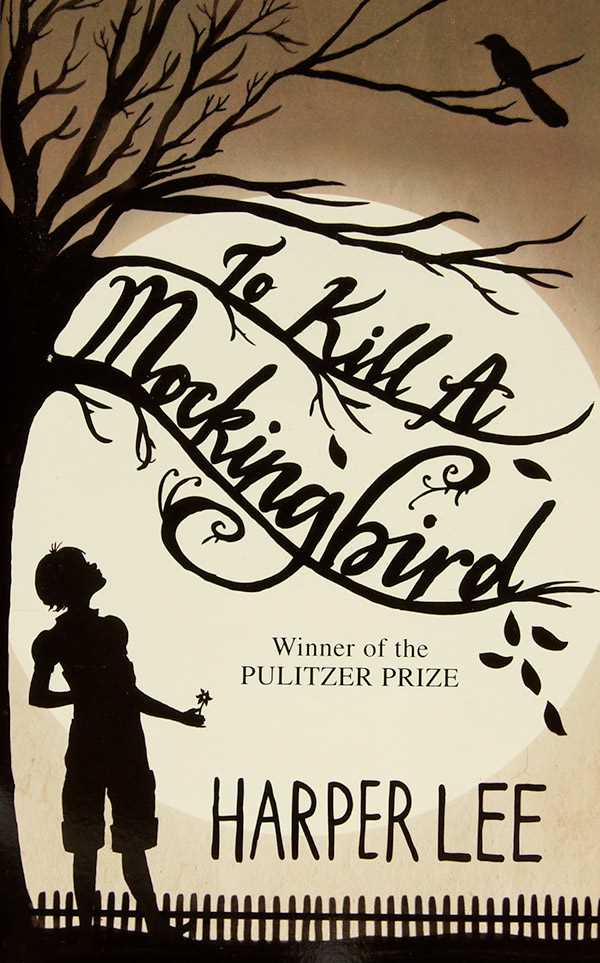
The novel portrays the harsh realities of racial inequality, particularly through the lens of the legal system and societal attitudes in the American South. It exposes how racial prejudice permeates all aspects of life, influencing personal relationships, community dynamics, and even the legal proceedings. Central to the plot is the trial of an innocent man who becomes a victim of unjust treatment, a powerful commentary on the systemic discrimination faced by marginalized communities.
The way race influences the characters’ lives is not limited to the courtroom. It extends to their daily interactions, as well as the expectations and limitations placed on individuals based on their race. Through the experiences of various characters, the novel challenges readers to reflect on the deeply ingrained prejudices that shape their world, urging a reevaluation of justice, fairness, and human dignity.
| Event | Racial Injustice Depicted |
|---|---|
| Tom Robinson’s Trial | The unjust trial of an innocent Black man, where racial bias influences the verdict despite overwhelming evidence of his innocence. |
| Mayella Ewell’s Testimony | Mayella’s false accusations against Tom Robinson reveal the deep-seated racism and the tendency to believe a white person’s word over a Black man’s. |
| Atticus Finch’s Defense | Atticus, a white lawyer, faces backlash for defending Tom Robinson, showcasing the town’s resistance to questioning racial norms. |
| Mob Outside the Jail | A mob of white men attempts to lynch Tom Robinson, illustrating the violent and dehumanizing lengths some are willing to go to maintain racial hierarchy. |
These key events, among others, are used throughout the novel to illustrate the pervasive nature of racial injustice. The way characters like Atticus and Scout respond to these events provides insight into the moral and ethical dilemmas of challenging racial inequality. Ultimately, the novel urges readers to confront uncomfortable truths about their own biases and consider the importance of standing up against injustice in all its forms.
How Prejudice Affects the Community
In the novel, prejudice serves as a powerful force that deeply influences the dynamics of the community, shaping individuals’ behaviors and interactions. This bias affects not only the individuals targeted by it, but also those who perpetuate it and those who remain silent in the face of injustice. The town’s collective mindset reflects the broader societal issues of racism, classism, and moral complacency, creating a culture where people are judged based on their race or social standing rather than their character or actions.
The town of Maycomb is divided by social lines, with deep-seated prejudices influencing decisions, relationships, and even the legal system. These biases are evident in various aspects of the story, from the trial of an innocent man to the way people interact with one another on a day-to-day basis. This social division creates an environment where people’s perceptions are clouded by stereotypes, often leading to unfair treatment and damaging consequences.
The Legal System: The impact of prejudice is particularly evident in the courtroom, where a Black man’s guilt is assumed solely because of his race. Despite clear evidence of his innocence, Tom Robinson is convicted, showing how racial bias influences the pursuit of justice. The legal system, intended to uphold fairness, instead becomes a tool for maintaining racial hierarchies and reinforcing social inequalities.
Social Relationships: Prejudices also affect personal relationships within the community, making it difficult for people to connect across racial or social lines. Characters like Calpurnia, a Black woman working for the Finch family, face the daily challenges of navigating a world where they are treated as inferior. Even those who strive to be just, like Atticus Finch, find themselves at odds with the larger community, challenging long-standing beliefs that they know to be wrong.
Impact on Youth: Children, such as Scout and Jem, are especially vulnerable to the influence of prejudice. As they grow, they learn about the complexities of race and class through their experiences with others, such as their interactions with people like Boo Radley and Tom Robinson. Their understanding of right and wrong is constantly tested as they witness adults’ biases, forcing them to question the values they’ve been taught.
Ultimately, prejudice within the community creates a cycle of division, misunderstanding, and injustice. The novel highlights how deeply entrenched biases can shape individuals’ actions and perpetuate harm, but it also offers hope through the actions of characters like Atticus, who stand up for what is right even when it is difficult to do so. By challenging these prejudices, the characters seek to break the cycle and create a more just and compassionate community.
The Importance of Tom Robinson’s Trial
The trial of Tom Robinson serves as a pivotal event in the story, representing a critical moment for the characters and the broader community. It exposes the deep-seated racial prejudices that influence every aspect of life in Maycomb, particularly the legal system. The trial is not merely about seeking justice for an individual, but about confronting the social and moral divisions that define the town. Through this event, the novel challenges the concept of fairness and reveals the stark inequalities faced by marginalized groups in society.
The Legal Battle
At the heart of the trial is a legal contest that ultimately becomes a battle for the soul of the community. Tom Robinson, a Black man accused of a crime he did not commit, faces a biased jury and a justice system that is heavily skewed against him. Despite compelling evidence that proves his innocence, the deep-rooted racial bias of the town ensures that his chances for a fair trial are slim. This legal farce exposes the flaws in a system that should be impartial but is instead tainted by prejudice.
Social Consequences
The trial also serves as a mirror to the social climate of the time. It forces the community to confront uncomfortable truths about racism, class, and morality. While some, like Atticus Finch, attempt to challenge the status quo and uphold justice, others, like the Ewells, exploit the system for personal gain, highlighting the corrupt nature of the power structures in place. The outcome of the trial has far-reaching consequences, not just for Tom Robinson, but for those who witness the trial, including Scout and Jem, who are forced to reckon with the complexities of right and wrong.
Ultimately, Tom Robinson’s trial is a symbol of the broader racial injustice that permeates society. It stands as a moment of moral reckoning, where characters are forced to examine their own values and beliefs. The trial becomes a catalyst for change, sparking a larger conversation about equality, fairness, and the need for a society that upholds justice for all its members, regardless of their race or status.
The Evolution of Boo Radley’s Character
Throughout the story, the character of Boo Radley undergoes significant development, transitioning from a mysterious figure surrounded by fear to a symbol of compassion and protection. Initially seen as a source of gossip and terror, Boo’s true nature gradually emerges, revealing a deeply misunderstood individual whose actions challenge the perceptions of those around him. His transformation in the eyes of the children, particularly Scout and Jem, reflects the broader theme of judgment and empathy within the narrative.
In the early stages of the novel, Boo is portrayed as a frightening, almost mythical figure, confined to his home and the subject of countless rumors. The children, particularly Scout, are both terrified and fascinated by the idea of Boo, crafting wild stories based on their limited knowledge and imagination. The townspeople, too, play a part in perpetuating these myths, reinforcing Boo’s image as a figure to be feared.
From Fear to Understanding
As the story progresses, Scout and Jem begin to realize that their initial assumptions about Boo are misguided. They start to notice subtle signs that suggest Boo might not be the monster they once believed him to be. For instance, Boo leaves small gifts for the children in the tree knothole, an act of kindness that begins to break down the walls of fear surrounding his character. This marks the beginning of a shift in the children’s perception of him.
Revealing the Truth
The turning point in Boo’s character arc occurs when he steps out of the shadows to protect Scout and Jem from harm. In this moment, Boo’s true nature is revealed: far from the sinister figure of town folklore, he is a compassionate, selfless individual who has been quietly observing and caring for the children. His actions, though shrouded in mystery, speak to his inherent goodness, which had been overlooked by the community due to their prejudice and fear.
- Boo’s initial portrayal as a source of fear and superstition.
- Small acts of kindness that challenge the children’s assumptions.
- The ultimate reveal of Boo as a protector and symbol of compassion.
Ultimately, Boo Radley’s evolution in the story emphasizes the importance of not judging others based on assumptions or outward appearances. His transformation from a feared figure to a hero mirrors the novel’s broader message about understanding, empathy, and the dangers of prejudice. Through Boo, readers learn that true character is often hidden beneath the surface, and that compassion can emerge from the most unlikely of sources.
The Influence of Calpurnia on Scout
Calpurnia plays a significant role in shaping Scout’s character, serving not only as a caretaker but also as a moral guide. Although initially seen by Scout as strict and harsh, Calpurnia’s actions and wisdom gradually teach Scout important lessons about empathy, social norms, and the complexities of race. Through her interactions with Scout, Calpurnia acts as both a disciplinarian and a mentor, helping the young girl navigate the challenges she faces in growing up in a divided community.
Calpurnia’s Role as a Teacher
One of the key aspects of Calpurnia’s influence is her role as a teacher. From the start, she imposes discipline in the Finch household, which Scout sometimes resents. However, over time, Scout comes to recognize that Calpurnia’s actions are driven by a desire to prepare her for the realities of the world beyond the safe confines of her home. Calpurnia’s firm yet caring approach provides Scout with a sense of responsibility and understanding of social expectations.
Lessons in Empathy and Equality
Another profound way Calpurnia shapes Scout’s character is by teaching her about empathy and equality. When Calpurnia takes Scout and Jem to her church, Scout is exposed to a different side of life and begins to realize the racial divide that separates people. Calpurnia’s ability to navigate between two different social worlds–her black community and the Finch household–serves as a powerful lesson in bridging divides and understanding people from different walks of life.
| Lesson | Example |
|---|---|
| Discipline | Calpurnia teaches Scout to behave properly and respect others, even when Scout disagrees. |
| Empathy | Through Calpurnia’s interactions with both black and white communities, Scout learns to empathize with people from all walks of life. |
| Equality | Calpurnia helps Scout understand the importance of treating everyone equally, regardless of their background or status. |
In conclusion, Calpurnia’s influence on Scout extends beyond mere household management. She teaches her valuable life lessons that help Scout mature and understand the world around her. Through her strength, wisdom, and care, Calpurnia shapes Scout’s understanding of social justice, respect, and compassion, making her one of the most important figures in Scout’s journey toward self-awareness and moral development.
Scout’s Growth Through the Story
Throughout the narrative, Scout evolves from a naive child into a more thoughtful and perceptive young girl. Her journey is marked by significant moments that challenge her understanding of right and wrong, justice, and human nature. As she encounters new experiences and perspectives, Scout begins to understand the complexities of the world around her, including the prejudices and moral dilemmas that shape her community. Her growth is not just emotional, but also intellectual, as she learns to see the world through the eyes of others.
Initially, Scout is a headstrong and impulsive girl, eager to defend her family and her beliefs. However, as the story progresses, she is exposed to harsh realities, such as racial inequality and societal injustice. These experiences force Scout to question her previous assumptions and consider the deeper meanings behind people’s actions and words. Her encounters with figures like Atticus, Calpurnia, and others serve as stepping stones in her personal development, helping her mature and reflect on the world in a more nuanced way.
One of the most important turning points in Scout’s growth occurs when she begins to grasp the importance of empathy and understanding. Through interactions with individuals who are different from her, Scout learns to appreciate the complexities of human behavior, realizing that people often act based on their circumstances, experiences, and beliefs. This shift in perspective helps Scout grow not only as a person but also as a member of her community, learning to value fairness, compassion, and integrity over blind judgment.
The Impact of the Novel’s Setting
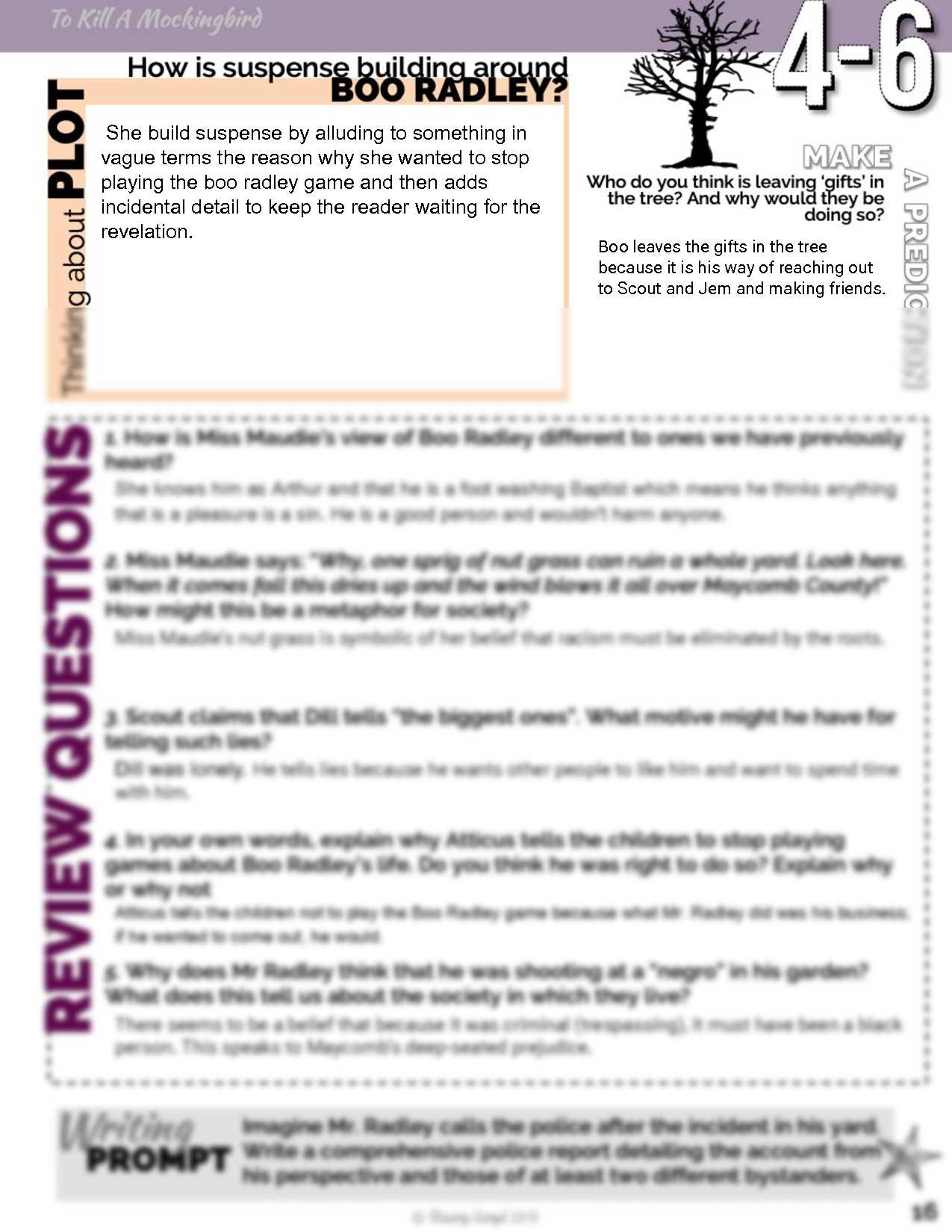
The environment in which a story unfolds plays a significant role in shaping its themes and characters. In this case, the town where the plot is set serves as more than just a backdrop; it acts as a reflection of the societal issues the novel addresses. The setting of a small Southern town during the Great Depression not only frames the narrative but also highlights the deep-seated racial tensions, class disparities, and moral conflicts that drive the story’s events. The geographic and social context enhances the reader’s understanding of the characters’ struggles, choices, and growth.
Small Town Dynamics and Social Structure
The close-knit nature of the community is crucial to the development of the story. In a town like Maycomb, where everyone knows each other’s business, public opinion and social norms carry significant weight. These dynamics are vital in illustrating the impact of prejudice, as characters like Tom Robinson are judged by the town’s deeply ingrained biases rather than by facts. The setting reveals how these collective attitudes influence individual actions, often leading to injustice and misunderstanding.
The Influence of the Historical Context
Set during the 1930s, the novel also reflects the economic struggles of the time, further shaping the characters’ lives. The era of the Great Depression is marked by poverty and hardship, which exacerbates the racial divides and social inequalities present in the town. The setting in this particular historical moment creates a backdrop that underscores the significance of the characters’ actions and the stark contrasts between personal values and societal expectations.
Ultimately, the novel’s setting is not just a physical location but a framework that drives the narrative. It underscores the prevailing attitudes of the time and emphasizes the moral dilemmas faced by the characters. The way the town interacts with the events unfolding highlights the impact of culture, history, and social structure on individual lives and decisions.
The Conflict Between Good and Evil
The tension between morality and corruption stands at the heart of this narrative. Characters are often forced to confront the differences between right and wrong, not in abstract terms, but through real-life challenges that expose the complexity of human nature. The novel presents various forms of evil, from systemic racism to personal biases, and contrasts them with acts of courage, justice, and compassion. The ongoing struggle between these opposing forces shapes both the actions of the characters and the overall message of the story.
Personal Struggles with Morality
Throughout the narrative, key characters grapple with their own moral compasses. Atticus Finch, for example, embodies integrity and justice, seeking to do what is right even when it is unpopular or dangerous. His unyielding commitment to fairness stands in stark contrast to the prejudices of those around him. His role as a father also emphasizes the importance of instilling moral values in the next generation, particularly in his children, Scout and Jem.
Social and Institutional Evil
The community itself is also a battleground for this moral conflict. The institutionalized racism and social inequalities that pervade the town act as a representation of the broader evil that the characters must contend with. The town’s prejudices create an environment where innocent lives are affected by injustice, as seen in the trial of Tom Robinson. This trial is not just a personal matter for the characters involved but a larger commentary on the pervasive wrongs in society.
The novel ultimately suggests that while evil may be entrenched in systems and individuals, the fight against it requires collective action, moral courage, and unwavering integrity. Through the experiences of the characters, the reader witnesses how the lines between good and evil are often blurred, but also how personal choice can still stand as a beacon of hope in the face of overwhelming darkness.
Lessons About Empathy in the Book
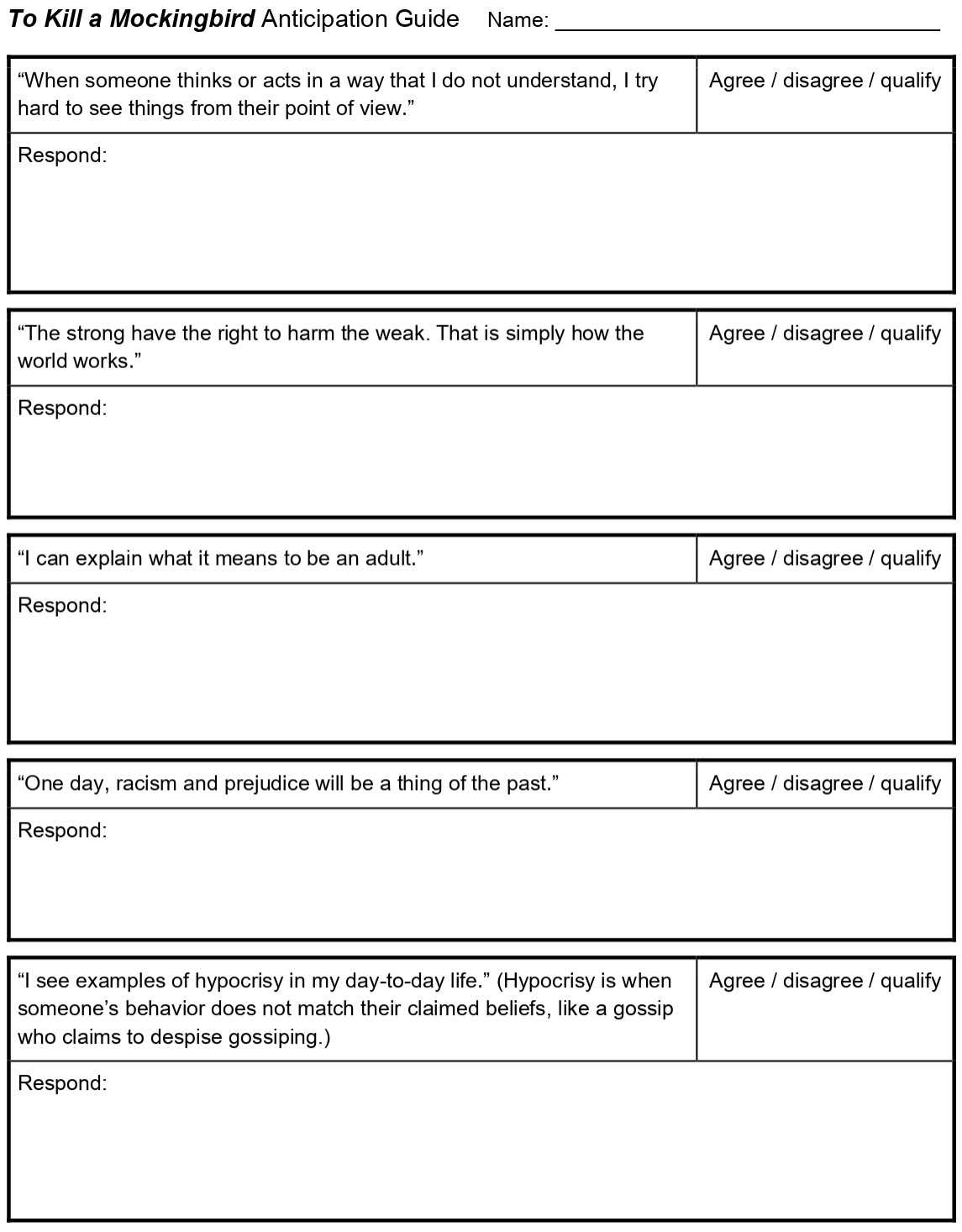
The novel explores the transformative power of empathy, teaching readers the importance of understanding others’ experiences and perspectives. Central to the story is the idea that true compassion arises when one is able to step outside their own comfort zone and see the world through another’s eyes. Throughout the narrative, characters are faced with moments where their ability to empathize influences their actions and decisions, shaping not only their personal growth but the moral lessons they impart to others.
One of the key lessons about empathy comes from the guidance of Atticus Finch. He teaches his children, Scout and Jem, to “climb into another person’s skin and walk around in it.” This philosophy emphasizes the need to look beyond superficial judgments, encouraging individuals to understand others’ struggles, fears, and motives. This lesson is particularly relevant as Scout matures and starts to grapple with complex social dynamics and prejudices in her community.
Additionally, the novel illustrates the significance of empathy in challenging societal norms. Characters such as Tom Robinson and Boo Radley are often misunderstood, and much of the conflict arises from a lack of compassion and the tendency to judge others based on preconceived notions. The more the characters engage with these misunderstood figures, the more they come to realize how empathy can dismantle false perceptions and encourage positive change.
Ultimately, the novel teaches that empathy is a powerful tool for breaking down barriers and fostering understanding in a divided world. Through the experiences of the characters, readers learn that empathy is not simply about feeling for others, but about acting in ways that reflect that understanding in our interactions with the world.
How the Story Reflects Social Issues
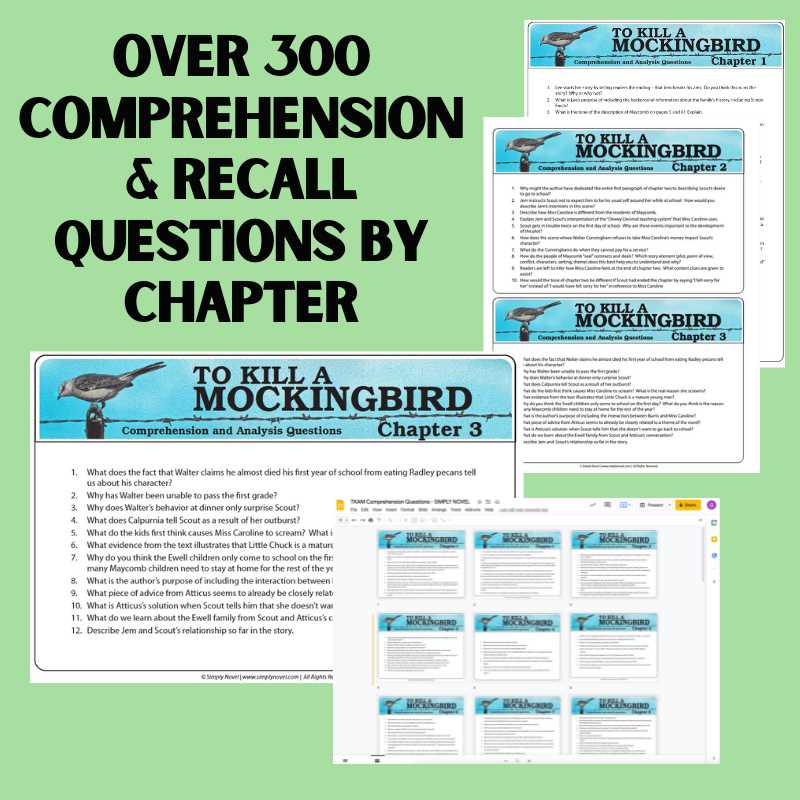
The narrative offers a sharp commentary on the societal struggles of its time, using the experiences of its characters to mirror the complexities of prejudice, inequality, and injustice. Set in the American South during the 1930s, the story touches on themes that are deeply woven into the fabric of the social landscape, highlighting how systemic discrimination and entrenched biases shape both individual lives and communities.
One of the central issues the story addresses is racial injustice, specifically through the trial of Tom Robinson, an African American man wrongly accused of a crime. His trial reveals the deep-seated racial prejudices that influence the legal system, making it clear how race can determine a person’s fate. The story captures the stark divide between the way different racial groups are treated, offering a critique of a society where justice is often not blind, but rather shaped by social status and skin color.
Beyond race, the novel also explores the role of class and gender in shaping people’s lives and interactions. The Finch family, though not wealthy, occupies a privileged position in their town due to their white status. Meanwhile, women like Scout are expected to conform to rigid gender norms, which limits their freedom and opportunities. The tension between societal expectations and individual desires is a recurring theme throughout the narrative.
The depiction of these social issues invites readers to reflect on the ways in which prejudice manifests in everyday life. It challenges them to question their own beliefs and behaviors, encouraging empathy and understanding for those who are marginalized or oppressed. Through its rich portrayal of these themes, the story remains a powerful tool for examining the social issues that continue to affect many societies today.